by Gary Sick
In the past few weeks, President Trump has given the world an instructive look at his negotiating style, as he lurches dangerously through the international china shop. I’m not talking here about his attempt to intimidate the leader of North Korea or intervene in the quarrel between American allies in the Persian Gulf. Those have not gone well.
Let’s focus instead on the Iranian nuclear deal, also known by its official initials JCPOA (Joint Comprehensive Plan of Action). Starting with his campaign appearances over more than a year, the president has denounced the agreement in the strongest possible terms. He has repeatedly stated that, if it were up to him (which, actually, it now is) he would have rejected it from the start. His administration has, however, on four separate occasions since January, acknowledged that Iran is carrying out its end of the bargain, that the previous sanctions on its nuclear activities should continue to be lifted, and that the agreement is in the vital national interests of the United States. Those declarations every 90 days are required by the Congress. But the president has chafed under these requirements and has virtually instructed members of his administration to find a way to declare Iran out of compliance.
Most recently, from the podium at the United Nations, President Trump described the JCPOA as an embarrassment. That is actually a signal that he regards the agreement as something that was done by his nemesis, President Obama, and Iran. In fact, the agreement was negotiated over more than three years and involved all the permanent members of the United Nations Security Council plus Germany, under the auspices of the European Union. Not only did they all agree and sign the highly technical agreement, that runs to more than 100 pages, but the agreement was also embedded in a Security Council resolution, which gives it the status of international law. When the president dismisses it as an embarrassment, he demeans all of the other signatories— our closest European allies and the two other most powerful nations in the world, Russia and China.
The president has not confirmed whether he will certify the agreement on October 15 or not. But let’s assume for a moment that all of this has been performance art, intended to draw attention to an agreement he does not like, prefatory to launching a major effort to change the terms of the agreement. Trump prides himself on his talents as a deal-maker. Adding new and tighter provisions to the agreement would indeed be a significant deal. Walking away means no deal at all.
Elements of a New Deal
So, if the objective is to change the deal, what exactly does Trump want to change? Based on statements by the president and those around him, there are three overriding issues: (1) the date at which the present extraordinary restrictions on Iran’s nuclear activities would begin to be removed; (2) Iran’s ability to carry out ballistic missile development; and (3) the fact that Iran is permitted to enrich uranium at all. Other points of concern have been mentioned: Iran’s support for Syrian President Bashar al-Assad, its support of Hezbollah in Lebanon, its support of the Houthis in Yemen, its harassment of U.S. and other shipping in the Persian Gulf, and its general “malign” influence in the Middle East. The first three items were considered in the non-proliferation negotiations of the JCPOA; the others are objections to Iran’s foreign and security policies.
The negotiators of the JCPOA deliberately avoided trying to stretch the agreement to cover geo-strategic concerns beyond the nuclear issue. There has been talk of a possible “grand bargain” with Iran since at least the days of the George W. Bush administration, but no U.S. president was prepared to undertake the daunting task of trying to pull all of these threads together in a single negotiating package. This would appear to be a challenge truly worthy of the man who was elected because his followers believed that he would bring business acumen and exceptional deal-making skills to the most powerful office in the world.
With no certainty about exactly what the president intends to do next, let’s hypothesize that he is interested in a grand bargain of some sort. That is at least consistent with his expressed concerns about Iran. The posturing about possibly leaving the JCPOA could be interpreted as a warning signal to everyone that he was serious about this and they had better pay attention. Since all the signatory countries want nothing to do with a revision, they had to be sufficiently startled to justify taking a second look. And there have been hints from some European countries that they might be willing to consider the idea. So the first move may have been successful.
But from that point on, it gets harder. Federica Mogherini, the high representative of the European Union for foreign affairs and security policy, who chaired the recent meeting of the JCPOA signatory states in New York, delivered a very clear message that the JCPOA is operating exactly as intended and should not be dismantled. The range of other issues related to Iran, she said, can be taken up in other ways and other places.
U.S. Options
If that is the authoritative position of the other signatories of the agreement, then President Trump has a limited set of options. He could initiate an entirely new multinational negotiation with Iran. Despite the demeaning language he has used in reference to the signatories and others, he might find a number of countries that would be willing to follow a strong American lead to examine the possibility of a grand bargain with Iran concerning a wide range of issues in the Middle East.
Alternatively, he could begin a bilateral process between the United States and Iran, using a combination of threats, pressure, and negotiation.
Finally, he might use U.S. leverage to make the JCPOA so unattractive to Iran that it would eventually walk away from the agreement entirely. Since Iran’s initial incentive for negotiating the JCPOA was to gain greater access to world markets and financing for its domestic development, the United States could use its unparalleled financial power to undercut any financial dealings with Iran, including by third countries. To some degree, that is what the U.S. is already doing, despite its promise to encourage a level playing field for Iran. This is a long game. It means bringing pressure on our allies and others to shun Iran, but there is no guarantee that it will bring down the Iranian economy in the short term. Still, the constant drumbeat of threats and pressure could no doubt persuade many foreign companies to take their investments elsewhere, while making sure that U.S. businesses were denied access to Iranian markets, as in the past.
The third option is the easiest for the Trump administration. It could continue to issue waivers and certify Iran’s compliance every 90 days while threatening in each case to walk away, a sort of cyclical, permanent, low-level crisis. Although it would not destroy the agreement, it would keep the kettle boiling enough to scare away most Western investors who have significant interests in the U.S. market that they do not wish to place at risk. However, there is no assurance that it would damage the Iranian economy sufficiently to force Iran to walk away from the agreement or to yield to U.S. demands for changes. Iran is looking increasingly to the East for investors and loans, and financing from Russia, China, and potentially even Japan may be enough to meet its basic needs for development and growth, even if that falls far short of what Iran had hoped for in the JCPOA negotiations.
What Can Trump Offer?
Whichever option the United States might choose, there are several inescapable facts that it must face. First, the U.S. must put something on the table. Neither Iran nor the other signatories will be prepared to undertake such an audacious set of negotiations unless there is something in it for them. In the first option, that means taking account of the interests of Iran and the Europeans at a bare minimum.
Second, even if the United States intends to do it alone, it must provide some incentive for Iran to open such wide-ranging discussions. What could the U.S. put on the table that would persuade Iran that it was worth the effort?
Third, whatever option is chosen, the United States would be advancing itself as the lead negotiator. No one else is going to take this on. So the United States must present a set of objectives that are sufficiently persuasive that all the parties—starting with Iran—would be able to justify their participation. What are the U.S. objectives? What do we want Iran to do about its nuclear program in the future? Should the present 10-20 year “sunset” clauses be altered? If so, what? 30 years? 40? 50? Forever? What kind of restrictions should be placed on Iran’s ballistic missile development? Since Iran sees missiles as a critical deterrence against neighbors equipped with high-performance aircraft, often provided by the United States, what kind of security assurances can be offered? If Iran’s relationship with Hezbollah is to be changed, and since Hezbollah provides strategic depth to Iran in relation to Israel, what kind of U.S. offers would persuade Iran to make a major strategic shift?
The United States or its allies in the Middle East have never really addressed these and other fundamental issues.
One central fact that emerges from this hypothetical exercise is that the United States, in order to make real progress on such an ambitious plan, must have the support of most of its major allies. The Trump administration to date has not been cultivating those allies or giving them reason to have great confidence in U.S. credibility and reliability.
But it is also painfully clear that no progress on these issues will be made without a direct engagement with Iran. Calling Iran names from a distance is not a strategy to bring it into a fruitful negotiation. Over the course of years, the Obama administration slowly built up a set of personal and professional relationships with Iran that succeeded in smoothing away some disputes. By the end of the negotiations, a limited degree of trust had been established between the long-time enemies. That, many believed, was the most promising path to taking the JCPOA beyond its narrow confines and into the arena of political disputes. The Trump administration has rejected all of that.
President Trump has set himself an ambitious program to transform the JCPOA and to influence Iranian behavior in a different direction. Thus far, his approach has favored headlines over any real progress. He has until October 15 to demonstrate that he is truly the master of the deal.
Gary Sick, a scholar at Columbia University, served on the National Security Council under Presidents Gerald Ford, Jimmy Carter and Ronald Reagan and was the principal White House aide for Iran during the Iranian Revolution and the hostage crisis. Photo: EU High Commissioner Federica Mogherini talks with Secretary of State Rex Tillerson.

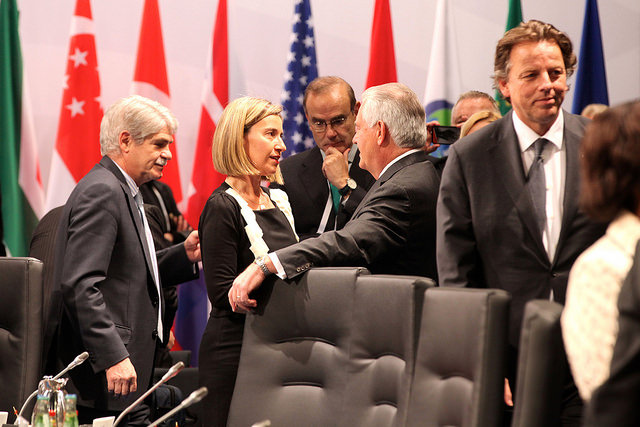
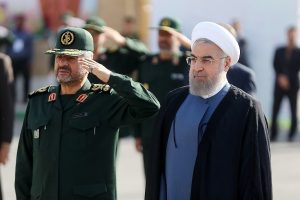
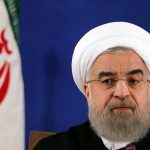
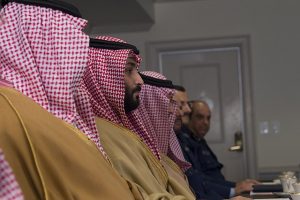
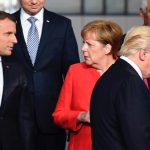
Trump knows the art of the deal, but unfortunately for all of us, only one kind: the mob boss kind. That is the only deal he has ever done, the kind where he presents his demands and the other party either agrees or ends up at the bottom of the East river.
Sometimes, he’s the one fitting the cement shoes- and sometimes he’s the one trying them on. There are examples where he himself recognizes that the other party could put him at the bottom of the river, so he caves utterly. Like the Pelosi and Schumer deal. But most of the time he’s the one with the trowel. Either way it’s the only art and the only deal he can do: the kind of deal Al Capone would understand.
He has never shown the slightest interest in the other parties to his deals. He does not discuss. He does not negotiate.
Trump is a gangster. This is the only way he knows.
God help us.